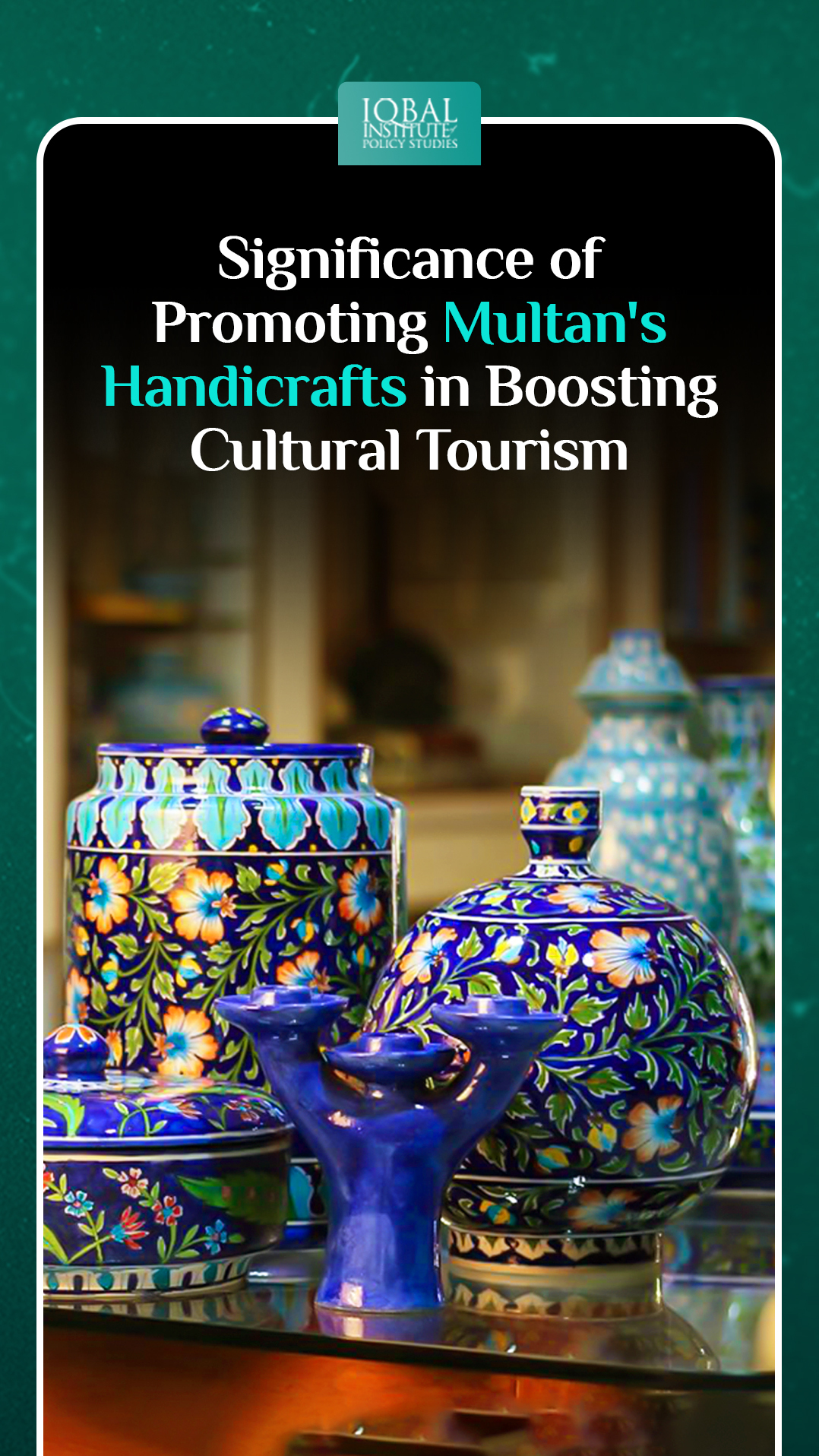Handicrafts are part of a tangible cultural heritage of all nations and a core tourism development element. Countries like Iran have attracted many tourists by promoting their symbolic handicrafts, including Persian carpets and miniatures. Industries like pottery, needlework, inlay, mat weaving, ceramics, etc., are manifestations of the ancient culture that attracts tourists. Pakistan has been blessed with several cities with aesthetics, cultural heritage, and history, which can help boost tourism. One of the oldest cities in South Asia, Multan is largely famous for being the adobe and the resting place of many Sufi saints and exponents of Sufi belief, which reflects the oldest Tughluq architecture. The city is also considered a hub of the oldest artefacts, including the famed blue pottery, influenced by Persian, Central Asian and Mongolian art. Despite so much importance, only a little effort has been made to promote Multan’s handicraft industry.
In this article by the Iqbal Institute of Policy Studies, we will discuss the significance of promoting Multan’s handicrafts in boosting tourism.
Multan- A Hub of the Country’s Handicraft Industry
Cherishing a significant historical background, which is 5000 B.C. old, Multan is called the sister of Rome. It lies in the centre of Pakistan on the bank of river Chenab in Punjab. The city holds a significant history dating back to Alexander the Great, followed by Arabs in the 8th century, and later on conquered by Mahmud of Ghazna in 1005. The city is famous for being the resting place of several sufi saints like Hazrat Bahauddin Zakariya and Shah Rukn e Alam. Having a long history, Multan reflects one of the oldest cultural aesthetics, in the form of blue pottery, camel skin lamps, and camel bone jewellery to decorative pieces, leather Multani Khussa, and wood crafts. Reflecting the traditional aspects with the traditional shawls, Chunri-making (tie and dye), mirror embroidery, frescos, Khaadi fabric, and many others increase Multan’s commercial importance. Considering the historical textile tradition, the city can better represent the new challenges about the social, cultural and economic hybridisation for all those investors and foreign companies that want to approach these markets.
Major Handicrafts of Multan
Following are the famous handicrafts of Multan, which have the potential to become the region’s attraction for tourists, contributing to the country’s revenue and boosting economic growth.
Blue Pottery
Multan, the cultural centre of southern Punjab mostly famous for its sufi shrines, cotton and sohan halwa, is also considered a hub for the craft of blue pottery. The skill of creating blue pottery, known as Kaashi work, is introduced 100 years ago by local craftsmen. Persia, China, Iran, and Mongolia influenced the art. However, for centuries, blue ceramics in Multan developed its unique, indigenous style. Blue pottery enjoyed the cronyism of royalty and was used as utensils, decorative tiles and architecture. In Mutlan, Shah Rukne Alam’s mausoleum, Shah Ali Akbar’s shrines, and Shah Yousuf Gardezi all incorporate tiles exhibiting classic Kashi work, which is conspicuous in blue pottery. However, being an integral part of Multan’s rich heritage, the craft is in decline due to the lack of patrons. Commercially, there are few places where their work is done. For instance, a few shops are present in the Daulat gate area.
Camel Skin Artefacts
Making artefacts from camel skin is a workmanship polished in Multan around a thousand years ago. Multan’s Camel skin lamp is famous worldwide for the unique handwork done on them and is known as Naqshi. The artefacts made from camel skin can be used for 50 to 100 years as it requires liqueur which protects them for a longer period. However, the centuries-old camel skin craft is quickly losing its shine amid declining product demand due to high prices.
Multani Khussa
Being the fifth largest city in Pakistan, Multan has been a major region for business and trade. It is also home to some of the finest handicrafts, mainly Multani Khussa. The city is considered a hub for traditional footwear in Pakistan and is exported to countries like Germany, Italy, the Netherlands, the United States and Saudi Arabia (World Bank, 2020). The traditional khussas are made from leather with gold embroidery. Khussa is one of the most used footwear in Pakistān in urban and rural areas.
Promoting Multan’s Handicrafts to boost tourism
Handicrafts act as cultural souvenirs that play a significant role in boosting tourism. In countries like India and Iran, handicrafts are considered the key element of tourism development, and tourism facilities have been built near the major production centres. Some countries have tried to represent their originality and identity by providing new products made through a combination of their national symbols with their handicrafts. Similarly, being one of the famous handicrafts, blue pottery, camel skin artefacts, Multani khussas and other artefacts should be considered important by promoting the industry. The government should dedicate special attention to the handicraft industry by making a cultural development plan. Organising large handicraft workshops and knowledge-based centres for handicrafts, forming export committees, exploring new markets, and making efficient policies to encourage more producers to be active in international markets should be added to the national development plan. It has been observed that promoting artefacts can become a great attraction for art lovers who travel worldwide to seek different art cultures, resulting in the growth of the country’s handicraft production and sale.
Conclusion
Tourism is very close to human nature and helps people learn and experience the culture and adventure nature offers. It is undoubtedly a huge revenue generation sector and promotes the country’s soft image toward the world. Cultural heritage plays an important role in shaping a country’s image. Fortunately, Pakistan is gifted with beautiful landscapes and a vibrant cultural history unmatched by any other place. Hence, preserving and promoting the country’s heritage and culture can help boost tourism.



Leave a Reply